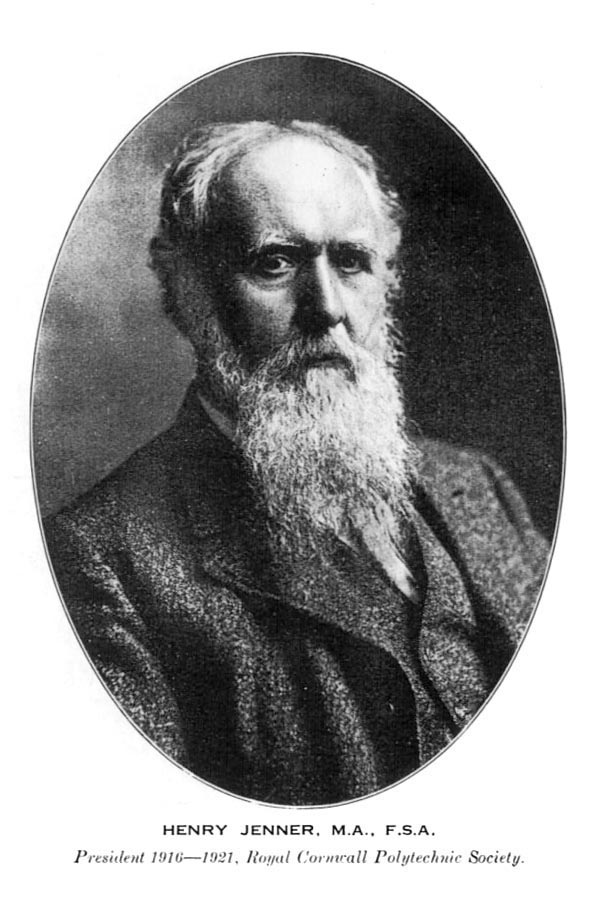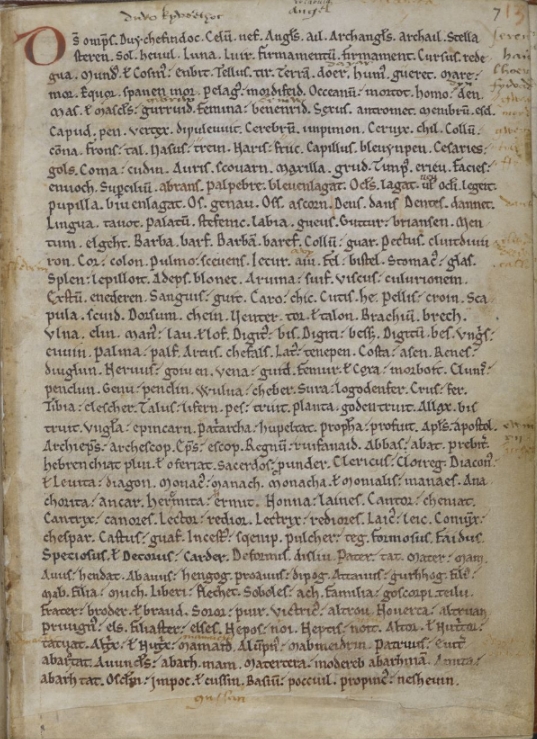|
Cranken Rhyme
The "Cranken Rhyme" is a Cornish-language song known by farmer John Davey or Davy (1812–1891), who was one of the last people with some knowledge of the tongue. It was recorded by J. Hobson Matthews in his ''History of St. Ives, Lelant, Towednack, and Zennor'', and is probably the latest known traditional Cornish verse. Matthews records the song in a chapter on the Cornish language and the evidence for its late survival. It is not clear whether he ever met Davey, or if he was relying on second-hand testimony. Jenner, Henry''A Handbook of the Cornish Language'' page 23. Either way, the song is unknown from any other source, demonstrating that Davey had knowledge of some original Cornish in the late 19th century. Matthews himself thought the song to be merely a jumble of place-names, which Davey was reputed to be able to decipher. However, Robert Morton Nance respelled the song into a recognizable form and provided an English translation. It is evidently a bit of humour claiming ... [...More Info...] [...Related Items...] OR: [Wikipedia] [Google] [Baidu] |
Cornish Language
Cornish (Standard Written Form: or ) , is a Southwestern Brittonic language, Southwestern Brittonic language of the Celtic language family. It is a List of revived languages, revived language, having become Extinct language, extinct as a living community language in Cornwall at the Last speaker of the Cornish language, end of the 18th century. However, knowledge of Cornish, including speaking ability to a certain extent, continued to be passed on within families and by individuals, and Cornish language revival, a revival began in the early 20th century. The language has a growing number of second language speakers, and a very small number of families now raise children to speak revived Cornish as a first language. Cornish is currently recognised under the European Charter for Regional or Minority Languages, and the language is often described as an important part of Cornish identity, culture and heritage. Along with Welsh language, Welsh and Breton language, Breton, Cornish is ... [...More Info...] [...Related Items...] OR: [Wikipedia] [Google] [Baidu] |
John Davey (Cornish Speaker)
John Davey or Davy (1812–1891) was a Cornish farmer who was one of the last people with some traditional knowledge of the Cornish language.Bruxelles, Simon de (21 May 2008)"After centuries, Cornish agree how to speak their language" ''The Times''. According to Henry Jenner, the level of his ability in the language is unclear, but was probably restricted to a few words and phrases.Jenner, p. 23. A song attributed to Davey's memory, the "Cranken Rhyme", is not known from any earlier source and is notable as possibly one of the last survivals of Cornish literary tradition. History Davey lived in the hamlet of Boswednack in Zennor parish. A farmer who served as a schoolmaster in Zennor for a period,Ellis, p. 129. he reputedly learned his Cornish from his father.Matthews, p. 404. He died in 1891, aged 79, taking his knowledge with him. John Hobson Matthews mentions Davey in his ''History of St. Ives, Lelant, Towednack, and Zennor'', published in 1892, the year after Davey's death ... [...More Info...] [...Related Items...] OR: [Wikipedia] [Google] [Baidu] |
Cornish Literature
Cornish literature refers to written works in the Cornish language. The earliest surviving texts are in verse and date from the 14th century. There are virtually none from the 18th and 19th centuries but writing in revived forms of Cornish began in the early 20th century. Medieval verse and drama '' The Prophecy of Ambrosius Merlin concerning the Seven Kings'' is a 12th-century poem written ''ca.'' 1144 by John of Cornwall in Latin, with some of the marginal notes in Cornish. John stated that the work was a translation based on an earlier document written in the Cornish language. The manuscript of the poem, on a codex currently held at the Vatican Library, is unique. It attracted little attention from the scholarly world until 1876, when Whitley Stokes undertook a brief analysis of the Cornish and Welsh vocabulary found in John's marginal commentary. These notes are among the earliest known writings in the Cornish language. In 2001 this important work was translated back into ... [...More Info...] [...Related Items...] OR: [Wikipedia] [Google] [Baidu] |
Henry Jenner
Henry Jenner (8 August 1848 – 8 May 1934) was a British scholar of the Celtic languages, a Cornish cultural activist, and the chief originator of the Cornish language revival. Jenner was born at St Columb Major on 8 August 1848. He was the son of Henry Lascelles Jenner, who was one of two curates to the Rector of St. Columb Major, and later consecrated though not enthroned as the first Bishop of Dunedin and the grandson of Herbert Jenner-Fust. In 1869 Jenner became a clerk in the Probate Division of the High Court and two years later was nominated by the Primate at Canterbury for a post in the Department of Ancient Manuscripts in the British Museum, his father then being the Rector of Wingham, a small village near Canterbury. In 1904, he successfully campaigned for Cornwall to join the Celtic Congress. He jointly founded the Old Cornwall Society at St Ives in 1920 and in 1928 he was a joint founder of the Cornish Gorsedh. Work with the Cornish language His earliest int ... [...More Info...] [...Related Items...] OR: [Wikipedia] [Google] [Baidu] |
Robert Morton Nance
Robert Morton Nance (1873–1959) was a British writer and leading authority on the Cornish language, a nautical archaeologist, and joint founder of the Old Cornwall Society. Nance wrote many books and pamphlets on the Cornish language, including a Cornish dictionary, which is a standard work, and edited magazines and pamphlets about Cornwall, including ''Old Cornwall'', the journal of the Federation of Old Cornwall Societies. Nance was also a nautical archaeologist of distinction and was an originator of the Society for Nautical Research. His insight and learning were displayed in his book ''Sailing-ship Models'' which appeared in 1924. He studied art in Britain and France and was both a painter and a skilled craftsman. Work with the Cornish language In 1898, Robert Morton Nance wrote "The Merry Ballad of the Cornish Pasty".Hall, Stephen (2001) ''The Cornish Pasty''. Nettlecombe: Agre Books Nance began studying the Cornish language in 1904 from Henry Jenner's A Handbook ... [...More Info...] [...Related Items...] OR: [Wikipedia] [Google] [Baidu] |
Penzance
Penzance ( ; kw, Pennsans) is a town, civil parish and port in the Penwith district of Cornwall, United Kingdom. It is the most westerly major town in Cornwall and is about west-southwest of Plymouth and west-southwest of London. Situated in the shelter of Mount's Bay, the town faces south-east onto the English Channel, is bordered to the west by the fishing port of Newlyn, to the north by the civil parish of Madron and to the east by the civil parish of Ludgvan. The civil parish includes the town of Newlyn and the villages of Mousehole, Paul, Gulval, and Heamoor. Granted various royal charters from 1512 onwards and incorporated on 9 May 1614, it has a population of 21,200 (2011 census). Penzance's former main street Chapel Street has a number of interesting features, including the Egyptian House, The Admiral Benbow public house (home to a real life 1800s smuggling gang and allegedly the inspiration for ''Treasure Island''s "Admiral Benbow Inn"), the Union Hotel (includi ... [...More Info...] [...Related Items...] OR: [Wikipedia] [Google] [Baidu] |
Marazion
Marazion (; kw, Marhasyow) is a civil parish and town, on the shore of Mount's Bay in Cornwall, UK. It is east of Penzance and the tidal island of St Michael's Mount is half-a-mile offshore. At low water a causeway links it to the town and at high water passenger boats carry visitors between Marazion and St Michael's Mount. Marazion is a tourist resort with an active community of artists who produce and sell paintings and pottery in the town's art galleries. Marazion lies within the Cornwall Area of Outstanding Natural Beauty (AONB). Almost a third of Cornwall has AONB designation, with the same status and protection as a National Park. On the western side of the town is Marazion Marsh, a RSPB reserve and a Site of Special Scientific Interest (SSSI). History of Marazion Remains of an ancient bronze furnace, discovered near the town, tend to prove that tin smelting was practised here at an early period. Marazion was not recorded in the Domesday Book of 1088. Its only chart ... [...More Info...] [...Related Items...] OR: [Wikipedia] [Google] [Baidu] |
Standard Written Form
The Standard Written Form or SWF ( kw, Furv Skrifys Savonek) of the Cornish language is an orthography standard that is designed to "provide public bodies and the educational system with a universally acceptable, inclusive, and neutral orthography". It was the outcome of a process initiated by the creation of the public body Cornish Language Partnership, which identified a need to agree on a single standard orthography in order to end previous orthographical disagreements, secure government funding, and increase the use of Cornish in Cornwall. The new form was agreed in May 2008 after two years of negotiations, and was influenced by all the previous orthographies. The negotiating teams comprised members of all the main Cornish language groups, Kesva an Taves Kernewek, Kowethas an Yeth Kernewek, Agan Tavas, and Cussel an Tavas Kernuak, and received input from experts and academics from Europe and the United States. The agreement meant that Cornish became officially accepted and fu ... [...More Info...] [...Related Items...] OR: [Wikipedia] [Google] [Baidu] |
Cornish-language Literature
Cornish ( Standard Written Form: or ) , is a Southwestern Brittonic language of the Celtic language family. It is a revived language, having become extinct as a living community language in Cornwall at the end of the 18th century. However, knowledge of Cornish, including speaking ability to a certain extent, continued to be passed on within families and by individuals, and a revival began in the early 20th century. The language has a growing number of second language speakers, and a very small number of families now raise children to speak revived Cornish as a first language. Cornish is currently recognised under the European Charter for Regional or Minority Languages, and the language is often described as an important part of Cornish identity, culture and heritage. Along with Welsh and Breton, Cornish is descended from the Common Brittonic language spoken throughout much of Great Britain before the English language came to dominate. For centuries, until it was pushed westw ... [...More Info...] [...Related Items...] OR: [Wikipedia] [Google] [Baidu] |






